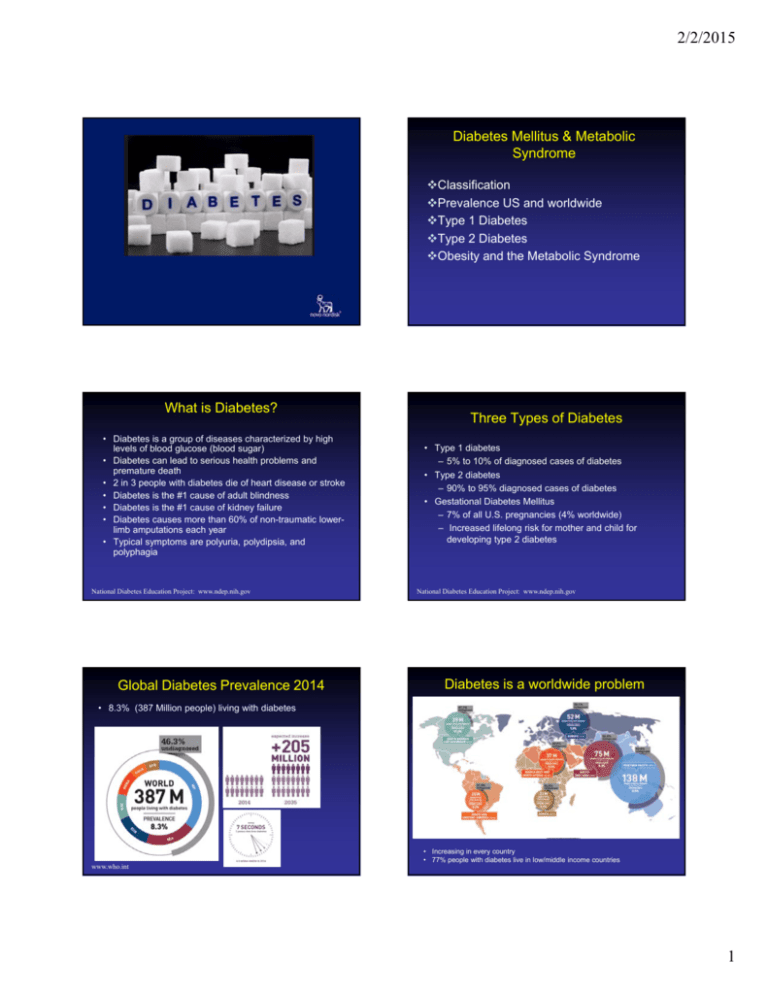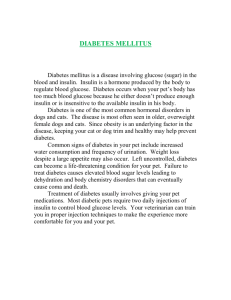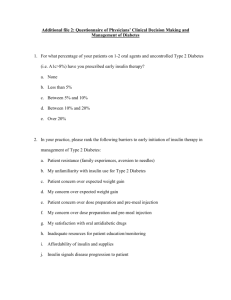
2/2/2015
Diabetes Mellitus & Metabolic
Syndrome
Classification
Prevalence US and worldwide
Type 1 Diabetes
Type 2 Diabetes
Obesity and the Metabolic Syndrome
What is Diabetes?
• Diabetes is a group of diseases characterized by high
levels of blood glucose (blood sugar)
• Diabetes can lead to serious health problems and
premature death
• 2 in 3 people with diabetes die of heart disease or stroke
• Diabetes is the #1 cause of adult blindness
• Diabetes is the #1 cause of kidney failure
• Diabetes causes more than 60% of non-traumatic lowerlimb amputations each year
• Typical symptoms are polyuria, polydipsia, and
polyphagia
National Diabetes Education Project: www.ndep.nih.gov
Global Diabetes Prevalence 2014
Three Types of Diabetes
• Type 1 diabetes
– 5% to 10% of diagnosed cases of diabetes
• Type 2 diabetes
– 90% to 95% diagnosed cases of diabetes
• Gestational Diabetes Mellitus
– 7% of all U.S. pregnancies (4% worldwide)
– Increased lifelong risk for mother and child for
developing type 2 diabetes
National Diabetes Education Project: www.ndep.nih.gov
Diabetes is a worldwide problem
• 8.3% (387 Million people) living with diabetes
• Increasing in every country
• 77% people with diabetes live in low/middle income countries
www.who.int
1
2/2/2015
Number of US adults with diagnosed Diabetes
USA Prevalence 2012
– 9.3% US population!
– Diagnosed: 21 million people
– Undiagnosed: 8.1 million people (28%)
http://www.cdc.gov/diabetes/data/statistics/2014StatisticsReport.html
Percentage of US adults with diagnosed diabetes (by county) 2008
Age of Adults with Diabetes
Newly diagnosed
% with diabetes
892,000
25.9
16.2
400,000
371,000
12.3
4.1
Total 20yr +
20‐44
45‐64
20‐44
65+
Estimated percentage of people with diabetes
(diagnosed and undiagnosed)
by age in US, 2009-2012
45‐64
65 +
Number of newly diagnosed cases of
diabetes, by age group, US 2012
2009-2012 National Health and Nutrition Examination Survey
Gender differences?
Age-adjusted* percentage of people aged 20 years or older
with diagnosed diabetes, by race/ethnicity,
United States, 2010–2012
13.6
11.2
Men
Source: 2009-2012 National Health Interview Survey
Women
Age adjusted % of people 20yr+ diagnosed with diabetes
Diagnosed and undiagnosed diabetes among adults (20yr + in USA 2012)
18
16
14
12
10
8
6
4
2
0
15.9
12.8
13.2
9
7.6
Non Hispanic
whites
Asian
Americans
Hispanics
Non‐Hispanic American
blacks
Indians/Alaska
Natives
*Based on the 2000 U.S. standard population.
Source: 2010–2012 National Health Interview Survey and
2012 Indian Health Service’s National Patient Information Reporting System.
2
2/2/2015
Estimated lifetime risk of developing
diabetes
Rate of new cases of type 1 and type 2 diabetes among people
younger than 20 years, by age and race/ethnicity, 2008–2009
LIfetime risk of diabetes (%)
60
50
40
Overall
30
Non‐hispanic white
Non‐Hispanic black
20
Hispanic
10
0
Men
Gregg et al , Lancet, 2014
women
for individuals born in the United States in 2000-2011
<10 years
10–19 years
Source: SEARCH for Diabetes in Youth Study. NHW=non-Hispanic whites; NHB=non-Hispanic blacks; H=Hispanics;
API=Asians/Pacific Islanders; AIAN=American Indians/Alaska Natives.
Who is affected?
Estimated Cost of Diabetes
• US Total: $245 billion in 2012 (41% increase from 2007)
• $1 healthcare in $5 in USA
• Worldwide: $612 billion in 2014 ($1 healthcare in $9)
direct
medical cost
$69 indrect (lost
productivity)
$176 Diabetes Care. 2013;36(4):1033- 1046,
www.idf.org
Acute Problems in Diabetes
Hyperglycemia: polyuria, polydipsia, polyphagia with
weight loss, Na+ & K+ imbalances, weakness/fatigue,
glycosylation of proteins, increased osmolarity of serum
(increased concentration of solute),
Ketoacidosis: decreases blood pH, HCO3-2, Hb avidity for
O2; leads to hypoxic coma &/or tachycardia
Hypoglycemia (especially in treated diabetics): lack of
brain glucose leads to neuropathy & coma, autonomic
hyperactivity
Long-term complications of Diabetes
Microvascular
• Retinopathy: leading cause of blindness in US adults
• Nephropathy: leading cause of kidney failure requiring dialysis
• Neuropathy: 60-70% of diabetics develop some form of nerve
disease
• Amputation: diabetes is the major cause of non-trauma leg
amputation.
Macrovascular
• Cardiovascular disease (1.7x higher death rate in diabetics)
• Stroke (1.5x higher in diabetes)
3
2/2/2015
Criteria for the Diagnosis of Diabetes Mellitus
EVERY 24 HOURS
+ symptoms
•
New Cases – 5,200
•
Deaths – 810
•
Amputations – 230
•
Kidney Failure – 120
•
Blindness - 55
Oral Glucose Tolerance Test:
Drink glucose solution (1.75 g/kg bw or 75 g max).
Measure blood glucose at 0, 30, 60, 90 and 120 min.
National Diabetes Education Project: www.ndep.nih.gov
Characteristics of Type 1 Diabetes
What are the 3 symptoms of diabetes?
•
•
•
•
•
•
•
A. Pain, Polydipsia, Polyuria
B. Perspiration, Polyphagia, Polydipsia
C. Polyploidy, Psoriasis, Polyuria
D. Pain, Polyploidy, Polydactyly
E. Polydipsia, Polyphagia, Polyuria
Type 1 Diabetes
• Beta cell destruction
– Usually leading to absolute
insulin deficiency
• Immune mediated
FasL
IFN
TNF
T cell
Class I
MHC
Macrophage
TNF
IL-1
NO
Dendritic cell
Etiology of Type 1 Diabetes
Inflammation
Autoimmune Reaction
Class II
MHC
Hypoinsulinemia (↓insulin levels)
~5-10% of diagnosed diabetes cases
Patients require insulin
Age of onset: childhood
Ketoacidosis (↑ketones in blood)
3 million people with T1DM in US
Peak incidence occurs during puberty
10-12 in girls, 12-14 in boys
Beta cell
CD8+ T cell
Beta cell Destruction
•
•
•
•
Autoimmune disease
Selective destruction of β-cells by T cells
Both genetic & environmental factors are important
Cause of autoimmune attack unknown
• Circulating antibodies develop:
Islet Cell Cytoplasmic Autoantibodies (ICA) (detected in 70-80% new cases)
Glutamic Acid Decarboxylase Autoantibodies (GADA) (80% new IDDM)
Insulin Autoantibodies (IAA) (detected in 40% in new kids with IDDM)
• >90% destruction of islets needed for symptoms
??
American Diabetes Association. Diabetes Care. 2003;26:S33–S50.
4
2/2/2015
Progression of Type 1 Diabetes
Type 1 Diabetes has a strong genetic component
Precipitating event
Genetic
predisposition
Antibody
formation
Normal insulin
release
Progressive loss of
insulin release
Glucose
normal
Beta Cell
Mass
Overt diabetes
C-peptide
present
No C-peptide
present
Time
• 0.4% risk of occurrence if no family history
• 6‐11% if offspring of parent with T1D
• 5% in siblings has T1D
• 30‐40% risk if twin has T1D
(monozygotic = 30‐65%, Dizygotic 6‐10%)
Atkinson MA and Eisenbarth GS. Lancet. 2001;358:221–229.
Type 1 Diabetes susceptibility loci
implicated in T1D
Bakay et al, Genes, 2013
Insulitis in islets before onset of T1DM
Immune and non immune genes implicated in Type 1 Diabetes
2006 = 6 genes associated with T1D
2012 = 60+ genes associated with T1D
Bakay et al, Genes, 2013
What triggers immune destruction?
Environmental Factors
Viruses
Enteroviruses e.g Coxsackie
Congenital Rubella (10-20% develop T1DM)
Mumps, measles, CMV
Normal human islet
Insulitis in pre-diabetic
(Lymphocytic infiltration)
Nutrition
Early exposure to Cow’s milk or gluten
Vitamin D deficiency
5
2/2/2015
Type 1 Diabetes
Genes
+
Induction of
autoimmunity
Immune regulation
What has not been linked to type 1 diabetes?
Environment
Trigger
A.
B.
C.
D.
E.
The suspect
Cytokines and
cytotoxic molecules
The weapons
Beta cells
Gluten
Coxsackie Virus
Mumps
Vitamin D deficiency
Lentivirus
The victims
Blood sugar Regulation
Resting state
Insulin
Glucagon
10 g/h
4 g/h
Glucose
4.5 mM
6 g/h
Characteristics of Type 2 Diabetes Mellitus
Type 1 Diabetes
Insulin
Glucagon
>20 g/h
<1 g/h
Glucose
8 - 10 mM
>14 g/h
6 g/h
•
•
•
•
•
•
•
•
•
•
•
Adult onset
Polygenic and environmental influence
Normal to low insulin levels
Obesity linked (70-90%)
May be asymptomatic
3 P’s: polyuria, polydipsia, polyphagia
Weakness/fatigue
Glycosuria
Dry, itchy skin
Visual changes
Skin and mucous membrane infections
6
2/2/2015
Common genetic variants linked to T2DM
Monogenic forms of T2DM (rare)
Maturity Onset Diabetes in the
Young (MODY)
• 1-2% of cases of Diabetes
• Usually first occurs during
adolescence or early adulthood
• Autosomal dominant mutation in
genes involved in insulin secretion or
insulin action.
Risk Factors for Development of T2-DM
Risk Factors
Age
Body Mass Index (BMI)
BMI = weight (kg)/Height2 (m)
Magnitude
5-10 fold increase age > 40
vs. age ≤ 40
Ethnicity
African Americans
Hispanic Americans
Nauruans, Micronesia
Pima Indians, Arizona
Increase
1.5-2 fold
2-3
5-7
7 - 10
5-fold
Impaired Glucose Tolerance
BMI classifications
Relationship Between BMI and Risk of T2DM
93.2
Age-Adjusted Relative Risk
100
<18.5
18.5‐24.9
25‐29.9
30‐39.9
>40
Underweight
Healthy
Grade I overweight
Grade II Overweight
Grade III Overweight
Thin
Normal
Overweight
Obese
Morbid Obesity
Men
75
obese
overweight
Women
54.0
50
27.6
25
0
42.1
40.3
1.0
2.9
1.0
4.3
1.0
5.0
1.5
<22
<23
23
23.9
24
24.9
8.1
2.2
15.8
25
26.9
27
28.9
4.4
Body Mass index
6.7
29
30.9
21.3
11.6
31
32.9
33
34.9
35+
(kg/m2)
Chan J et al. Diabetes Care 1994;17:961.
Colditz G et al. Ann Intern Med 1995;122:481.
7
2/2/2015
Conversion from Impaired Glucose Tolerance
to Diabetes
The % of abdominal fat rather than the BMI
per se is associated with changes in insulin
sensitivity
14
12
Rate
per
year
(%)
10
8
6
BMI < 25
BMI > 25
4
Ito, et al.
6932 Japanese
with GTT followed
for 1-28 years
2
<140
140-169
170-199
2h plasma glucose level (mg/dL)
after 75 gm OGTT at baseline
Increased BMI and increased baseline glycemia
both increase conversion from IGT to Diabetes
Men
Women
Distribution by Metabolic Status Among Converters to T2DM
(83% of Prediabetic Subjects are Insulin Resistant)
A.
B.
C.
D.
E.
Both
(54%)
Insulin resistant;
good insulin
secretion (28.7%)
Waist Circumference
Substantially Increased Risk
>102 cm
Which group has the highest risk of diabetes?
Low insulin secretion; insulin
sensitive (15.9%)
Neither (1.5%)
Increased risk
>94 cm
>88 cm
Pima Indians
Nauruans
Hispanic Americans
African Americans
Caucasian Americans
Haffner SM et al. Circulation. 2000;101:975-980.
Mechanism of Hyperglycemia in Diabetes
B-cell dysfunction
Type 2 Diabetes: Lack on insulin effect on peripheral tissues
Glucagon
Insulin Resistance
Insulin
Insulin
Insulin
Insulin
Insulin
Increased hepatic
glucose production
Reduced insulin
Liver
Adipose
Decreased glucose uptake
(muscle and adipose)
Glycogenolysis
Gluconeogenesis
Lipogenesis
Lipolysis
Glucose uptake
Protein synthesis
Fasting Blood Glucose
Plasma FFA and Glycerol
Fed Blood Glucose
Plasma Amino Acids
Hyperglycemia
8
2/2/2015
Insulin resistance: impaired glucose uptake
into skeletal muscle and fat in T2DM
Natural History of Type 2 Diabetes
Insulin resistance increases, then stabilizes, occurs many years prior to Diabetes
Glucose Uptake (mg/kg/min)
Splanchnic (liver and intestine)
8
Adipose
Beta cell – initial compensation for insulin resistance, serum glucose in normal range
Muscle
6
Brain
Insulin Resistance
Insulin Secretion
4
100%
2
-20
-10
0
10
20
30
Years of Diabetes
0
Normal
Basal
Type 2
Insulin Stimulation
50
Bergenstal RM, et al. Endocrinology 4th ed, 2000.
Natural History of Type 2 Diabetes
Obesity
IGT
Diabetes
Postmeal Glucose
Plasma
Glucose
Fasting Glucose
100
75
120 mg/dL
Insulin Resistance
Relative
Beta Cell
Function
Stages of Type 2 Diabetes
Uncontrolled
Hyperglycemia
Insulin Secretion
Beta Cell
Function 50
(%)
25
-20
-10
0
10
20
Years of Diabetes
Type 2
Phase 1
IGT
100%
Postprandial
Hyperglycemia
Type 2
Phase 2
30
0
-12 -10
-6
Secretory dysfunction develops and insulin secretion no longer able to compensate
Rise in fasting glucose, further compromises insulin secretion and action
-2
Type 2
Phase 3
0
2
6
10
14
Years From Diagnosis
Adapted from Lebovitz HE. Diabetes Reviews. 1999;7(3):139–153.
52
Bergenstal RM, et al. Endocrinology 4th ed, 2000.
Insulin secretion cannot be understood in isolation but only in
relationship to the individuals insulin sensitivity
Islet hyperplasia during compensation
If subjects with normal
glucose tolerance become
more insulin resistant by
gaining weight, they would
move to the left. If they can
compensate by increasing
their insulin secretion, they
may still remain glucose
tolerant.
Normal islet
Insulin
resistant
Islet from insulin
resistant mouse
Insulin
sensitive
S. Kahn, U.W.
9
2/2/2015
Amyloid in islets of T2DM
Which tissue takes up the most glucose in the insulin stimulated state?
A.
B.
C.
D.
Islet showing amyloid
deposits in T2DM
Normal islet
Brain
Muscle
Adipose
Liver & intestines
Progressive beta cell dysfunction: Delayed Insulin
Secretion
Impaired suppression of Hepatic Glucose Production
causes postprandial hyperglycemia
Patients with T2D have blunted and delayed insulin response,
and prolonged glucose excursion
Plasma Insulin
60
Fasting Plasma Glucose (FPG)
Level (mg/dL)
1.00
Plasma Glucose
< 144
< 215
215-270
> 324
Normal
0.80
360
270
(mg/dL)
180
40
(mU/L)
20
Mean Insulin
Level (nmol/L)
0.60
0.40
90
0
–1
0
1
2
3
4
5
–1
0
1
2
3
4
0.20
5
Hours After Glucose
Ingestion
0.00
Healthy Subjects
–30
0
30
60
Patients With Type 2 Diabetes
Glucose Excursions in Type 2 Diabetes
Meal
120
150
180
210
240
Coates, et al. Diabetes Res Clin Pract. 1994 Dec 31;26(3):177–187.
Mitrakou A, et al. Diabetes. 1990;39:1381–1390.
400
90
Time (min)
Meal
Meal
58
Insulin Secretion in Type 2 Diabetes
Meal
800
Meal
Meal
Normal
Type 2 diabetes
300
600
Diabetic
Insulin
Secretion 400
(pmol/min)
Glucose
(mg/dL) 200
200
100
Normal
0
0
0600
0600
1000
1400
1800
2200
0200
0600
1400
1800
2200
0200
Time (24hour clock)
Time of Day
Polonsky KS, et al. NEJM. 1988;21;318(19):1237-1239.
1000
59
Polonsky KS, et al. N Engl J Med. 1996 Mar 21;334(12):777-783.
60
10
2/2/2015
What is the mechanism for the development
of Insulin Resistance?
Obesity induced inflammation drives insulin resistance
Proinflammatory cytokines
Immune cell migration
Insulin resistance
Inhibition of insulin signaling
What is the mechanism of Insulin
Resistance?
1. Obesity causes chronic low grade inflammation –
Increased macrophage infiltration and altered
polarization
2. Excess lipid causes lipotoxicity
3. Obesity changes microflora in the intestines –
bacterial by products cause resistance
Excess lipid accumulation causes
insulin resistance
Why do some individuals with IGT progress to diabetes?
A.
B.
C.
D.
E.
Islet cells begin to fail
Insulin resistance increases
Autoimmune reaction occurs
Kidneys fail
Glucagon increases
11
2/2/2015
Prevalence of Self-Reported Obesity
Among U.S. Adults
Obesity
2000
1990
2011
2013
WA
ME
ND MN
VT NH
MA
SD
WI
N
RI
MI
CT
PAY
NJ
NE IA
DE
IL IN OH
MD
VA
KS MO KY WV
DC
NC
OK AR TN SC
AZ NM
MSAL GA
TX
LA
FL
OR ID
NV
CA
AK
2010
UT
MT
WY
CO
HI
15%–<20%
*BMI 30
No Data
<10%
10%–14%
15%–19%
20%–24%
25%–29%
≥30%
20%–<25%
25%–<30%
GUAM PR
30%–<35%
≥35%
• No state had a prevalence of obesity less than 20%.
• 2 states (Mississippi and West Virginia) had a prevalence of obesity of 35% or greater
CDC’s Division of Diabetes Translation. National Diabetes Surveillance System available at
http://www.cdc.gov/diabetes/statistics
Age-adjusted Prevalence of Obesity and Diagnosed Diabetes
Among U.S. Adults Aged 18 Years or Older
Insulin Resistance: Causes and Conditions
kg/m2)
Obesity (BMI ≥30
1994
No Data
2010
2000
<14.0%
14.0%–17.9%
18.0%–21.9%
22.0%–25.9%
26.0%
Activity
Obesity /
Lipodystrophy
Aging
Medications
Rare
Disorders
Genetics
Insulin Resistance
Diabetes
1994
2010
2000
Type 2
Diabetes
No Data
<4.5%
4.5%–5.9%
6.0%–7.4%
7.5%–8.9%
>9.0%
CDC’s Division of Diabetes Translation. National Diabetes Surveillance System available at
http://www.cdc.gov/diabetes/statistics
PCOS
Hypertension
Dyslipidemia
Neurodegeneration
Atherosclerosis
The Metabolic Syndrome:
Historical Perspective
Obesity and the Metabolic Syndrome
Target population for the prevention of Type 2 Diabetes and
Complications (~100 million diagnosed in the U.S.)
1988: Syndrome X
Abdominal obesity
(waist circumference : men: > 40 in, women: >35 in)
Insulin
Resistance
plus TWO of the following:
•
•
•
•
Fasting glucose > 100mg/dL
Blood pressure > 130/85 mm Hg
Triglycerides > 150 mg/dl
High-density lipoprotein cholesterol (good cholesterol)
(men: <40 mg/dl, women: < 50 mg/dl)
Glucose
Intolerance
Hyperinsulinemia
TG
HDL-C
Hypertension
CORONARY HEART DISEASE
Reaven G. Diabetes. 1988;37:1565-1607.
12
2/2/2015
Insulin Sensitivity Improves with Weight Loss
in Patients with Type 2 Diabetes
Modest Weight Loss Prevents Diabetes in
Overweight and Obese Persons with IGT
150
100
*
30
*
*
0
*P<0.01 vs before.
0-2.4
2.5-6.9
7.0-14.0
Placebo
20
50
Before
Cumulative Incidence
of Diabetes (%)
Insulin (pmol/L)
40
>15
Weight Loss at 1 Year (%)
Wing et al. Arch Intern Med 1987;147:1749.
10
Lifestyle
0
0
0.5
1.0
1.5
2.0 2.5
Year
3.0
3.5
4.0
Diabetes Prevention Program Research Group. N Eng J Med 2002;346:393.
Copyright © 2002. Massachusetts Medical Society. All rights reserved.
What is not associated with the Metabolic Syndrome?
A.
B.
C.
D.
E.
Atherosclerosis
Polycystic Ovary Syndrome
Diabetes
Hypertension
HIV infection
13









